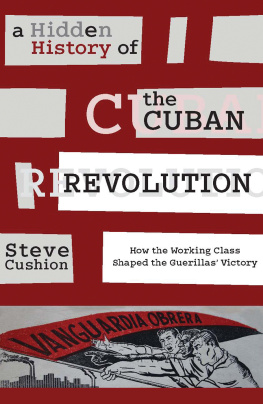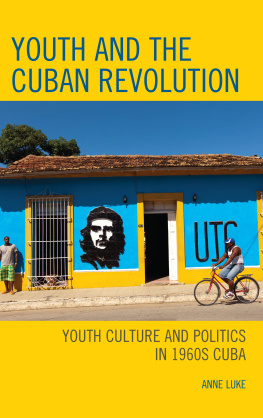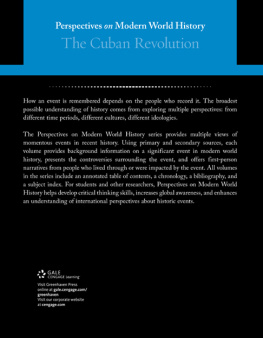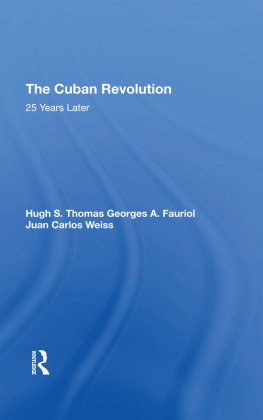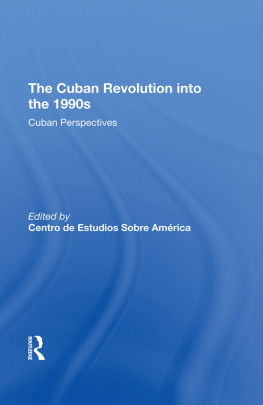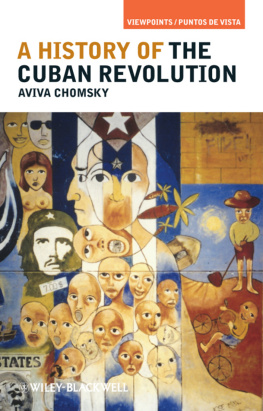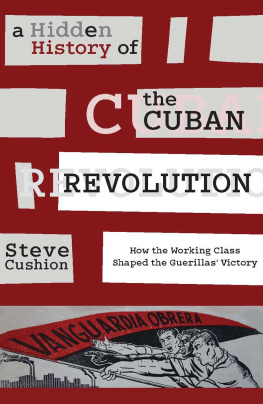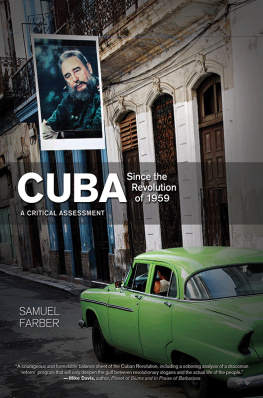Cushion Stephen - A Hidden History of the Cuban Revolution
Here you can read online Cushion Stephen - A Hidden History of the Cuban Revolution full text of the book (entire story) in english for free. Download pdf and epub, get meaning, cover and reviews about this ebook. year: 2016, publisher: Monthly Review Press, genre: Politics. Description of the work, (preface) as well as reviews are available. Best literature library LitArk.com created for fans of good reading and offers a wide selection of genres:
Romance novel
Science fiction
Adventure
Detective
Science
History
Home and family
Prose
Art
Politics
Computer
Non-fiction
Religion
Business
Children
Humor
Choose a favorite category and find really read worthwhile books. Enjoy immersion in the world of imagination, feel the emotions of the characters or learn something new for yourself, make an fascinating discovery.
- Book:A Hidden History of the Cuban Revolution
- Author:
- Publisher:Monthly Review Press
- Genre:
- Year:2016
- Rating:5 / 5
- Favourites:Add to favourites
- Your mark:
- 100
- 1
- 2
- 3
- 4
- 5
A Hidden History of the Cuban Revolution: summary, description and annotation
We offer to read an annotation, description, summary or preface (depends on what the author of the book "A Hidden History of the Cuban Revolution" wrote himself). If you haven't found the necessary information about the book — write in the comments, we will try to find it.
A Hidden History of the Cuban Revolution — read online for free the complete book (whole text) full work
Below is the text of the book, divided by pages. System saving the place of the last page read, allows you to conveniently read the book "A Hidden History of the Cuban Revolution" online for free, without having to search again every time where you left off. Put a bookmark, and you can go to the page where you finished reading at any time.
Font size:
Interval:
Bookmark:

STEVE CUSHION is a retired university lecturer with a Ph.D. in Caribbean Labor History who lives in the East End of London. For twenty years, he worked as a bus driver in London, and has been an active socialist and trade unionist all his adult life. He is currently adviser to the Museum of Labor History on the digitization of their archives.
A Hidden History
 of the
of the
Cuban Revolution
How the Working Class Shaped the Guerrilla Victory
by STEVE CUSHION

MONTHLY REVIEW PRESS
New York
Copyright 2016 by Steve Cushion
All Rights Reserved
Library of Congress Cataloging-in-Publication Data available from the publisher.
Monthly Review Press
146 West 29th Street, Suite 6W
New York, New York 10001
www.monthlyreview.org
Typeset in Bulmer
5 4 3 2 1
CONTENTS
For Mary Turner (19312013),
historian, teacher, comrade, and loyal friend
FOREWORD
The war constitutes an encouraging example of what can be achieved by the tenacity and revolutionary will of the people. The revolutionary armed combatants, in the final phase of the struggle, scarcely numbered three thousand men. Our workers and peasants, integrated into the Rebel Army, with the support of the middle class, pulverized the tyrannous regime, destroyed the armed apparatus of oppression, and achieved the full independence of the country. The working class, with its revolutionary general strike in the final battle, contributed decisively to the triumph [of the Revolution]. This brilliant feat of our Revolution in the military terrain is little known outside the country. It has been published in anecdotal and sporadic form, but a documented and systematic history of it remains to be written.
FIDEL CASTRO
F idel Castros retrospective analysis of the insurrectionary phase of the Cuban Revolution, delivered at the first Congress of the Cuban Communist Party in 1975, recognizes the contribution of the working class to the revolutionary struggle, but confines this contribution to two areas: active service in the rebel army and the general strike of January 1, 1959. Whereas the latter receives minimal attention in historical accounts of the Revolution, the deeds of the small band of revolutionary guerrillas continue to exert a powerful hold on popular and scholarly depictions of its eventual triumph. Despite the rhetorical invocations of the pueblo (the people) by the revolutionary leadership, and despite the official embrace of Marxist-Leninist ideology from 1961, there remains surprisingly little documented and systematic analysis of the contribution of Cuban workers to the eventual overthrow of the detested Batista regime. Yet, as this engaging and meticulously researched book amply demonstrates, a militant and well-organized labor movement, often operating independently of union leaders, played a pivotal role in the victory of the Cuban insurrection, not only through the final coup de grce of the 1959 general strike, but in myriad actions that served to defend workers interests, resist state repression, and materially support the armed struggle. Thus there was a third arm to the revolutionary forces, a labor movement, which has been consistently ignored by both general and labor historians of Cuba alike.
Scholarly neglect of the role of organized labor in the Cuban Revolution can be partly explained by the nature of the official trade union organization, the Confederacon de Trabajadores de Cuba (CTC), under the leadership of Eusebio Mujal. As this book vividly describes, the CTC leadership, working hand in glove with the Batista regime, was responsible for gross abuses including interference in union elections, removal from office of elected officials, expulsions of troublesome officials from the unions, and discrediting individual leaders by false or exaggerated accusations of Communism. By 1957, in the wake of further anti-communist purges carried out with the full backing of state security forces, the CTC was openly operating as Mujals personal fiefdom. However, in conflating organized labor with the corrupt bureaucracy of the CTC, scholars have overlooked or underestimated the activities of ordinary workers and the critical role they played in resisting not only the corrupt trade union leadership but also the iniquities of the Batista regime. Steve Cushions work calls for a broader definition of organized labor, looking beyond the formal structures of the trade union federation to include the multiplicity of unofficial, informal structures through which ordinary workers defend their interests. This includes the activities of shop stewards, independently minded union officials, strike committees, regional committees, mass meetings, and unofficial, as well as clandestine, networks of militants, all of which make up the wider labor movement and interact together to produce the dynamic of industrial action.
What emerges in this book is a lively and variegated picture of working-class activism that sheds new light on the struggles of workers, ranging from those employed in the more traditionally proletarian sectors of sugar,
This attention to local contexts constitutes one of the many contributions of this book. Looking beyond Havana to consider actions right across the island, Cushion highlights the existence of an energetic and independent milieu of local labor activism, acting autonomously from, and indeed in defiance of, the central labor leadership. For example, sugar workers at the Delicias y Chaparra mills in Las Tunas undertook strike action on their own terms after the mujalista union officials melted away at the first sign
Taken together, the workers struggles provide a compelling account of how organized labor contributed directly and indirectly to help shape the course of revolutionary struggle in 1950s Cuba. As Cushion depicts so vividly here, workers provided valuable material support for the rebel guerrillas in a number of ways, including organizing significant strike action in support of the Granma landing and armed uprising in Santiago. Workers in shops, warehouses, and distribution depots proved valuable by large-scale pilfering of essentials, railway workers were able to move those supplies under the noses of the police, and bus drivers formed propaganda distribution networks, while telephone operators eavesdropped on police conversations, providing vital intelligence for those more directly engaged in the armed struggle.capital, heading off a potential army coup, and ensuring the victory of the revolutionary forces. This analysis aligns with Castros own estimation of the strikes significance. Thus, for Cushion, the final victory of the revolutionary forces should be viewed as the result of a combination of armed guerrilla action and mass support.
Cushions analysis also casts a fresh eye on working-class politics in the period, assessing the relationship between organized labor and the two main organizations seeking to mobilize the working class: the PSP and the M-26-7. In so doing, he brings a new perspective to both, highlighting for example how local traditions of labor militancy directly contributed to the development of the M-26-7s network of clandestine workplace cells (the seccines obreras), and showing how mistakes made at the leadership level derived partly from their lack of experience of labor organizing, contributing to the failure of the general strike called for April 9, 1958. And though the PSP has often been considered a latecomer to the revolutionary struggle, Cushion underscores the immense contribution made by rank-and-file communists in sustaining levels of working-class discontent in areas where they had influence, often at considerable risk to their lives. Meticulously tracing the evolution of the relationship between the M-26-7 and the PSP, this book provides a much more nuanced picture of the internal debates within and between these two organizations, the points of commonality and difference in their respective approaches to confronting the Batista regime, and the local specificities informing the mixture of competition and collaboration that characterized relations between the two. Cushions detailed analysis of joint endeavors such as the Comits de Unidad Obrera and the Frente Obrero Nacional Unido (FONU) suggests that the coming together of the M-26-7 and the PSP started at the working-class base of both organizations. Local grassroots collaboration between PSP and M-26-7 members in the workplace provided a solid base for unity on which to construct the attempted national organization of a workers united front.
Next pageFont size:
Interval:
Bookmark:
Similar books «A Hidden History of the Cuban Revolution»
Look at similar books to A Hidden History of the Cuban Revolution. We have selected literature similar in name and meaning in the hope of providing readers with more options to find new, interesting, not yet read works.
Discussion, reviews of the book A Hidden History of the Cuban Revolution and just readers' own opinions. Leave your comments, write what you think about the work, its meaning or the main characters. Specify what exactly you liked and what you didn't like, and why you think so.

